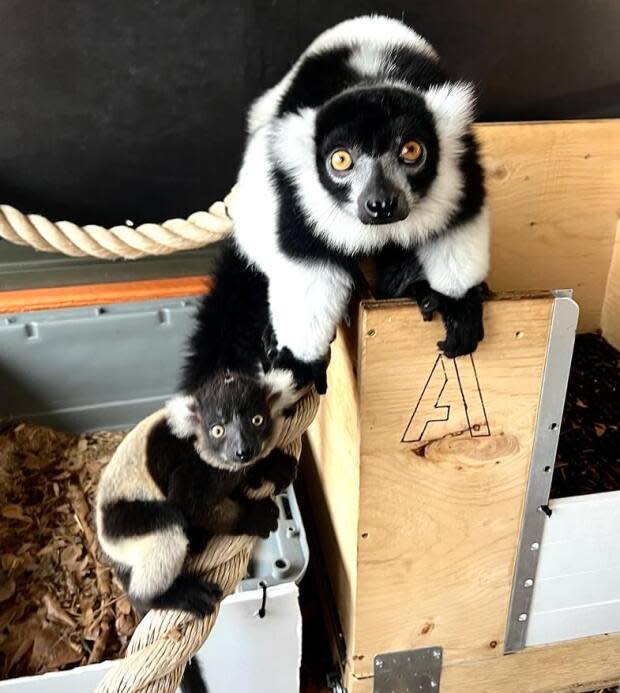Black-and-white ruffed lemur born at Calgary Zoo, first in 36 years

A bright-eyed, black-and-white ruffed lemur will soon be seen bouncing around the Calgary Zoo.
The baby lemur is one month old, born on April 7 to parents Eny and Menabe. It's the first of its species to be born at the zoo since 1987.
"The successful birth of this newest addition is especially exciting and important for Eny and Menabe's species," said Dr. Typhenn Brichieri-Colombi, conservation research and strategy advisor, in a new release from the Wilder Institute/Calgary Zoo.
"With black-and-white ruffed lemurs being critically endangered in the wild. This pup already plays an important role in the survival and well-being of its species."
The zoo hasn't determined the sex of the baby. Staff will likely wait until the pup receives its first vaccines — which happens at about 10 weeks old — to do a full examination.
Then, they'll determine how they want to give the infant its name.

Menabe arrived at the Calgary Zoo in 2017. The zoo works with other accredited zoos and aquariums taking part in a species survival plan (SSP) to find the right breeding partners for animals, supporting at-risk species. Eny came from a zoo in the Czech Republic in 2021.
So far, the little family is beginning to bond.
"[Eny's] just doing such wonderful mothering behaviour. So she's cleaning it. She's cuddling it. She's keeping it warm," said Colleen Baird, interim associate director of animal care and welfare at the zoo, in an interview with The Homestretch.
"They're not like a gorilla or other primate species, where [babies] cling to the back or the front of the mom. The mom … she has these nests high up in the canopy, and she'll travel with this pup in her mouth, moving it from nest to nest as she forages and feeds."
LISTEN | Colleen Baird explains why and how they acquire animals from other zoos:
Black-and-white ruffed lemurs are native to Madagascar. Habitat loss, agriculture, mining, deforestation and climate change have led to their decline, according to Baird.
The zoo works to protect three species of lemur in collaboration with the Madagascar Biodiversity Partnership and the University of Calgary, the release says, helping communities to develop reforestation activities, plant future habitats and improve local livelihoods.
They also work to educate people on why lemurs are so important.

"Sometimes they eat food with berries or seeds, and then they poop those seeds around. They are actually planting seeds in places for trees to grow," Baird said.
"This species is quite important for diversity in Madagascar, and if we just ignore them, then we lose some of those special moments."
The lemur walk-through at the zoo will be reopened on May 19, but the new baby won't join the conspiracy — what a group of lemurs is called — just yet. Baird says the pup needs to get stronger, first, but it may be seen later in the summer.


